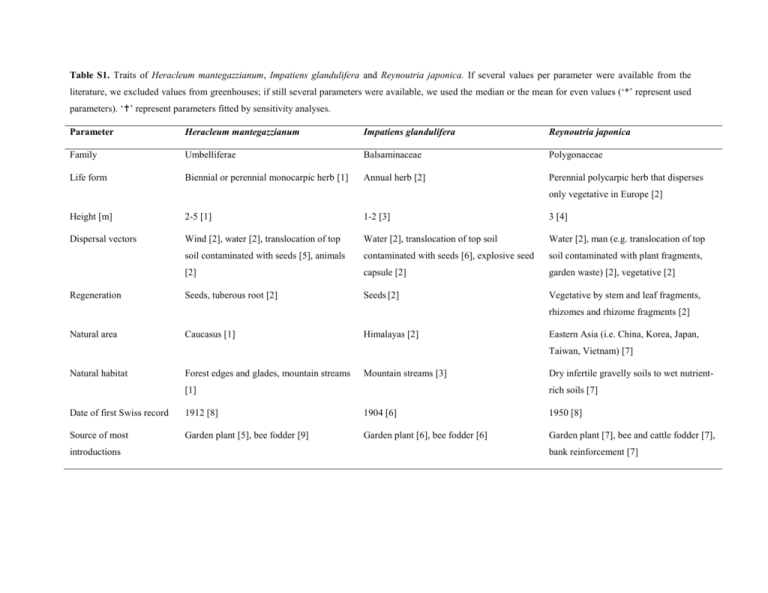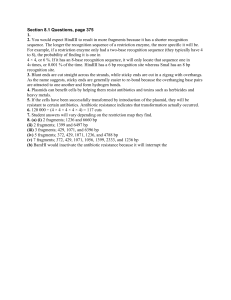Table S1. Traits of Heracleum mantegazzianum, Impatiens
advertisement

Table S1. Traits of Heracleum mantegazzianum, Impatiens glandulifera and Reynoutria japonica. If several values per parameter were available from the literature, we excluded values from greenhouses; if still several parameters were available, we used the median or the mean for even values (‘*’ represent used parameters). ‘’ represent parameters fitted by sensitivity analyses. Parameter Heracleum mantegazzianum Impatiens glandulifera Reynoutria japonica Family Umbelliferae Balsaminaceae Polygonaceae Life form Biennial or perennial monocarpic herb [1] Annual herb [2] Perennial polycarpic herb that disperses only vegetative in Europe [2] Height [m] 2-5 [1] 1-2 [3] 3 [4] Dispersal vectors Wind [2], water [2], translocation of top Water [2], translocation of top soil Water [2], man (e.g. translocation of top soil contaminated with seeds [5], animals contaminated with seeds [6], explosive seed soil contaminated with plant fragments, [2] capsule [2] garden waste) [2], vegetative [2] Seeds, tuberous root [2] Seeds [2] Vegetative by stem and leaf fragments, Regeneration rhizomes and rhizome fragments [2] Natural area Caucasus [1] Himalayas [2] Eastern Asia (i.e. China, Korea, Japan, Taiwan, Vietnam) [7] Natural habitat Forest edges and glades, mountain streams Mountain streams [3] [1] Dry infertile gravelly soils to wet nutrientrich soils [7] Date of first Swiss record 1912 [8] 1904 [6] 1950 [8] Source of most Garden plant [5], bee fodder [9] Garden plant [6], bee fodder [6] Garden plant [7], bee and cattle fodder [7], introductions bank reinforcement [7] Table S1. Continued. Water dispersal Mean distance [km] 1 [10] 3 [10] 3 [11] Maximal distance [km] 10 [5, 10] 20 [10] 20 [11] Seed release height [m] 4 [5] 2 [3] - Seed terminal velocity [m s- 1.92-2.66 [12] 4.24-4.72 [12] - Height of the surrounding c. 80% lower (meadows, parks, banks), c. 50% lower (banks), c. 50% higher (forest - vegetation [m] c. 20% higher (forest edges and glades, edges and glades, shrub) [2] Wind dispersal 1 ] shrub) [1] Demographic parameters Seedbank persistence [yr] 5 [13], 6* [5], 7 [www.neoflora.de] 2 [3] Fragments: <5 [notes Canton Zurich] Years until seeds germinate 1 [5] 1 [3] Fragments: 0 [14] Maximal germination rate 0.1 germinate and 0.02 survive to the 0.105-0.739 germinate, while most of the Regenerating fragments: 0.39* [18]; 0.6 first year [13], which results in an overall seedlings survive for low germination and from 2 nodes [19]. germination rate of 0.002; 0.27-0.9 only few survive for high germination [15], germinate and 0.012-0.137 survive the which results in an overall germination rate first season [5], which results in an of 0.105; 5000-6000 seeds m-2 [16] and 50- overall germination rate of 0.00324- 70 adults m-2 [17] results in an overall 0.1233*; 0.8-0.85 germinate and 0.6-0.8 germination rate of 0.01; Mean: 0.0575* survive [15], which results in an overall germination rate of 0.48-0.68. Table S1. Continued. Maximal yearly juvenile 0.23 of the seedlings survive to 1.0 1.0 [20] survival rate maturity [5], the yearly rate is hence 0.1 [1] 0.4 0.4 Demographic slope 10 10 50 First flowering [yr] 2 [5] 1 [2] 1 [14] Latest flowering [yr] 5 [5] 1 [2] 1 [14] Maximal percentage of 1.0 [1]; We used 0.25 because in reality 1.0 [21] Fragments: 1.0 [14] flowering adults adults die after flowering, which was 0.48*; 0.3-0.7 [15] Minimal juvenile to adult transition rate not accounted for in the model. Maximal number of seeds Mean c. 20’000 [13]; Maximum c. 800 [17]; 1886 x [(2 x plant density)-0.367] [3] 9.7 stem fragments + 2000 rhizome produced per individual in a 20’000-100’000 [5]; Mean: 50’000* results in 348 at carrying capacity and up to fragments m-2 / 42 individuals m-2 results 1010 for very low density stands with only 2-3 in c. 60 fragments per individual [20] individuals per m-2; Mean: 905* along the river, else 1. 42 [20] results in 26’250 in a 625m2-cell year Adult carrying capacity 2 [5] results in 1250 in a 625m2-cell; 30-40* [3] results in 25’000 in a 625m2-cell; [adults m-2] juvenile carrying capacity: 20 [5] 50-70 [17]; 20-80 [15] Number of individuals after 1 [22] 1 [3] 6 [23] 5 [5] 1 [3] 5 [24] clonal growth Maximal age [yr] Table S1. Continued. Other parameters Occurrence-probability 0.45 0.50 0. 50 0.20 0.20 0.20 threshold to translate predictions into binary presence-absence forecasts (OT; best Cohen’s kappa) Occurrence-probability where below transition rates drop to 0 (ZT; false negative rate <0.05)








